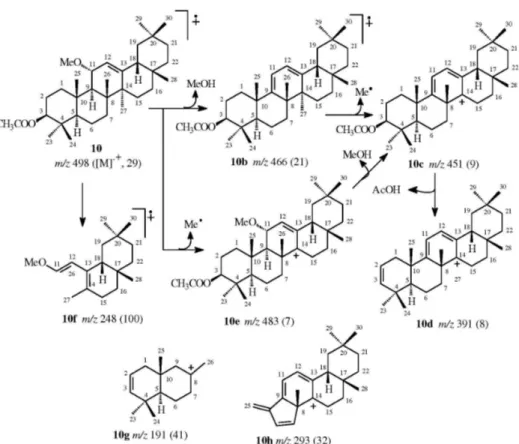Article
J. Braz. Chem. Soc., Vol. 21, No. 8, 1434-1438, 2010. Printed in Brazil - ©2010 Sociedade Brasileira de Química 0103 - 5053 $6.00+0.00
*e-mail: curcino@uenf.br
Chemical Constituents from
Aspidosperma illustre
(Apocynaceae)
Lara F. Barbosa, Leda Mathias, Raimundo Braz-Filhoand Ivo J. Curcino Vieira*
Laboratório de Ciências Químicas, Universidade Estadual do Norte Fluminense Darcy Ribeiro, 28013-602 Campos dos Goytacazes-RJ, Brazil
A partir de Aspidosperma illustre, foi obtido como produto natural um novo triterpeno da série oleanano, o olean-12-en-11α-metóxi-3β-acetato (10), além dos triterpenos β-amyrina (3), lupeol (4), acetato de β-amyrina (5), acetato de lupeol (6), olean-12-en-28-hidróxi-3β-tetradecanoato (7), olean-12-en-28-carboxi-3β-hexadecanoato (8), ácido ursólico (9) e dois alcalóides indólicos monoterpênicos, β-ioimbina (1) e 1,2-desidroaspidospermidina (2). As substâncias isoladas foram identiicadas através de métodos espectroscópicos, principalmente uni (RMN 1H, 13C, APT) e bidimensionais (1H-1H-COSY, 1H-1H-NOESY, HMQC e HMBC) e de massas, envolvendo também comparação com dados de literatura.
A new natural product oleanane-type triterpene, olean-12-ene-11α-methoxy-3β-acetate (10) was isolated from Aspidosperma illustre, together with β-amyrin (3), lupeol (4), β-amyrin acetate (5), lupeol acetate (6), olean-12-ene-28-hydroxy-3β-tetradecanoate (7), olean-12-ene-28-carboxy-3β-hexadecanoate (8), ursolic acid (9) triterpenes, and two monoterpenic indole alkaloids,
β-yoimbine (1) and 1,2-dehydroaspidospermidine (2). These compounds were characterized on their spectral data basis, mainly one- (1H, 13C, APT) and two-dimensional (1H-1H-COSY, 1H-1 H-NOESY, HMQC and HMBC) NMR, and mass spectra, involving also comparison with data from the literature.
Keywords: Aspidosperma illustre, Apocynaceae, oleanane triterpenes, alkaloids
Introduction
The Aspidosperma (Apocynaceae) genus is endemic to Americas and is found mainly in regions between Mexico and Argentina.1 Aspidosperma genus continues to be
fascinating as an expressive source of indole alkaloids with novel skeletons,2 which are interesting from a biosynthetic
perspective and reported biological properties.2,3 Species
of the Aspidosperma genus are applied broadly by popular medicine as potential antimalarial agents, leishmaniasis treatment, uterus and ovary inlammation, as contraceptive, in diabetes, in stomach problems, against cancer, fever and rheumatism.3
Aspidosperma illustre, commonly known as “Tambu-Pequiá” in Atlantic forests in the North of Espírito Santo State, appears as a tree of 5-20 m. This species is not reported on studies of chemical composition described in the literature.
In the present paper, we describe the isolation and characterization of a novel oleanane-type triterpene,
olean-12-ene-11α-methoxy-3β-acetate (10), along withseven known triterpenes, β-amyrin (3), lupeol (4), β-amyrin acetate (5), lupeol acetate (6), olean-12-ene-28-hydroxy-3β-tetradecanoate (7), olean-12-ene-28-carboxy-3β-hexadecanoate (8), ursolic acid (9) and two known monoterpenic indole alkaloids, β-yoimbine (1) and 1,2-dehidroaspidospermidine (2). The structures of known and new compound are being mentioned for the irst time in this species and were established on the basis of spectral data, mainly 1H and 13C (1D and 2D) NMR spectra, mass
spectrometry and by comparison with literature data.
Results and Discussion
The hexane and MeOH extracts of stem bark and leaves of A. illustre were subjected to a classical chromatographic methods to yield the a new oleanane-type triterpene, olean-12-ene-11α-methoxy-3β-acetate (10), in addition to known, β-amyrin (3),4 lupeol (4),4 β-amyrin acetate
(5),4 lupeol acetate (6),4
olean-12-ene-28-hydroxy-3β-tetradecanoate (7),4 olean-12-ene-28-carboxy-3β
Barbosa et al. 1435 Vol. 21, No. 8, 2010
and 1,2-dehydroaspidospermidine (2),10 were identiied
on the basis of 1H and 13C NMR spectral data, including 1H-1H-COSY, 1H-1H-NOESY, HSQC and HMBC NMR
experiments,11,12 which were also used to complete
unambiguous 1H and 13C chemical shift assignments of the
triterpenoid 10, the new natural product.
The pentacyclic triterpene (10) was obtained as an amorphous solid. Comparative analysis of {1H}- and APT-13C NMR spectra (Table 1), involving the corroboration
of 1H NMR spectra (1D 1H NMR and 2D 1H-1
H-COSY), allowed to recognize the presence of 33 signals corresponding to eight nonhydrogenated [(C)8: six sp3,
two sp2 (including one carbonyl groups at d
C 171.0 and
one sp2 oleinic at d
C 149.7], six methine [(CH)6: ive sp 3
(including two oxygenated linked to acetyl group at dC 80.8
and to methoxyl function at dC 75.7) and one sp
2 oleinic at
dC 121.8], nine methylene [(CH2)9, all sp
3] and ten methyl
[(CH3)10: including two oxygenated attributed to acetate (dC
21.4/dH 2.06, s) and methoxyl groups (dC 53.4/dH 3.21, s)]
carbon atoms, allowing to deduce the expanded molecular formula (C)7(C=O)(CH)6(CH2)9 (CH3)9(OCH3) for 10.
The LREI-MS (70 eV) spectrum of 10 showed of molecular peak [M+.] at m/z 498 Daltons, allowing in conjugation with the 13C NMR spectral data to propose
molecular formula C33H54O3 (10), containing seven degrees of unsaturation and consistent with the presence of one acetyl group and one double bond in a pentacyclic triterpenoid acetylated and methoxylated, compatible with the structure triterpenic sustaining an acetate group at carbon atom CH-3 [dC 80.8/dH 4.51 (dd, J 8.8 and
7.6 Hz)] in an β-amyrin skeleton (3, β-amyrin).4 In fact,
heteronuclear long-range coupling (3J
CH) of this carbon
atom (dC 80.8) with H-5 (dH 0.87, value approximated
deduced through of HMQC spectrum) and both methyl groups linked to quaternary carbon C-4 [dH 0.85 (3H-23)
and 0.88 (3H-24)], as shown in Table 1.
The 13C NMR spectrum of 10 revealed signals at d C
121.8 (CH-12) and at dC 149.7 (C-13), indicating the
presence of a trisubstituted double bond. In the HMQC spectrum a cross-peak correlation 1J
CH was observed
between the CH-12 at dC 121.8 and the singlet signal at dH
5.30, which was assigned to the vinylic hydrogen. The stereochemistry of the stereogenic carbons CH-3 and CH-11 of 10 was determined from the coupling constants of relevant hydrogens and from the observed
1H-1H-NOESY. The values corresponding to vicinal
interaction (3J
H,H) between the hydrogen atoms H-3 and H-2
suggested axial-axial interaction, since the H-3 signal (dH
4.51, dd, J 8.8 and 7.6 Hz) revealed axial-axial coupling (J 8.8 Hz, Table 1); similarly the multiplicity observed in the signal of the hydrogen H-11 (dH 3.88, dd, J 9.4 and 3.5 Hz)
Table 1. 1H (400 MHz) and 13C (100 MHz) NMR data of triterpene (10),
in CDCl3 as solvent and TMS used as internal reference. Chemical shifts (d, ppm) and coupling constants (J, Hz, in parenthesis)*
10
HMQC HMBC
dC dH
2J CH
3J CH C
4 38.0 - 3H-23; 3H-24
8 43.1 - H-9; 3H-26 3H-27
10 38.0 - H-5; 3H-25
13 149.7 - 3H-27
14 41.7 - 3H-27 H-9; 3H-26
17 32.3 - 3H-28
20 31.1 - 3H-29; 3H-30
1’ 171.0 - 3H-2’
CH
3 80.8 4.51
(dd, 8.8, 7.6)
H-5; 3H-23; 3H-24
5 55.3 0.87 3H-23; 3H-24;
3H-25
9 51.0 1.72 3H-25; 3H-26
11 75.7 3.88
(dd, 9.4, 3.5)
H-9 MeO-11
12 121.8 5.30
(d, 3.5)
3H-28
18 46.9 2.35 (m)
CH2
1 39.1 1.42, 1.22 H-9; 3H-25
2 23.8 1.72, 1.60
6 18.3 1.98 (t, 13.5), 1.69
H-5
7 33.2 3H-26
15 26.6 3H-27
16 26.7 3H-28
19 46.5 1.60, 1.30 3H-29; 3H-30
21 34.7 3H-29; 3H-30
22 37.0 3H-28
CH3
23 28.2 0.85(s) 3H-24
24 16.7 0.88 (s) 3H-23
25 16.9 1.07 (s) H-1b;H-9
26 18.2 1.00(s)
27 25.1 1.21 (s)
28 28.5 0.83 (s)
29 33.1 0.88 (s) 3H-30
30 23.7 0.88 (s) 3H-29
MeO-11 53.4 3.21 (s) Me-2’ 21.4 2.05 (s)
Chemical Constituents from Aspidosperma illustre (Apocynaceae) J. Braz. Chem. Soc. 1436
and both H-12 (dH 5.30, d, J 3.5 Hz) and H-9 (dH 1.72)
allowed to recognize axial-axial interaction of H-11ax with H-9ax, since the H-11 signal revealed axial-axial coupling (J 9.4 Hz, Table 1) and H-11ax and H-12eq by = 3.5 Hz, consistent with the relative coniguration shown in 10a. Consistent with these observations, the 1H-1H-NOESY
spectrum of 10 showed cross-peaks assigned to dipolar interaction (spatial proximity, vide10a) of H-11 (dH 3.88)
with 3H-25 (dH 1.07) and 3H-26 (dH 1.00); hydrogen atoms
of the methyl group present in the 3β-O-acetyl (dH 2.05)
with both 3H-23 (dH 0.85) and 3H-24 (dH 0.88).
The oxidation at CH-11 of 10 is adequate to introduce signiicant modiication in fragmentation of this pentacyclic triterpene containing double bond between the carbon
atoms CH-12 e C-13 in the mass spectrometer, revealing the absence of peaks produce by reaction Retro-Diels-Alder (RDA), as observed in other triterpenes with such characteristics.13,14
Conirmation ofstructure 10 was done by comparison with authentic sample of derivative monoacetate of triterpene 11-α-methoxy-β-amyrin isolated from Myroxylon balsamum (Fabaceae).15
According to the literature, the triterpene 10 was also obtained as an intermediate reaction by allylic oxidation by N-bromosuccimide with β-amyrin acetate.16
Thus, the pentacyclic isolated from Aspidosperma illustre was characterized as olean-12-ene-11α -methoxy-3β-acetate (10), a new natural product.
Barbosa et al. 1437 Vol. 21, No. 8, 2010
The results of the extensive application of 1D and 2D NMR spectral techniques were also used to conirm the structure and to establish the 1H and 13C resonance
assignments of 10 (Table 1).
Experimental
General procedures
Optic rotation measures were obtained on a Perkin Elmer 343 digital polarimeter. Melting points were obtained on a Microquímica MQRPF and are uncorrected. FTIR spectra were recorded on a FTIR-8300 Shimadzu spectrometer using KBr disk. ESI-MS (high resolution) mass spectra were obtained on a MICROMASSUltrOTOF-Q (Brüker Daltonics, Billerica, MA) mass spectrometer, using the negative ion mode of analysis and EI-MS (low resolution) mass spectra were obtained on Shimadzu QP5050A mass spectrometer. Column chromatographic puriications were carried out over silica gel (70-230 mesh). Silica gel 60F254 was used in thin layer chromatography analysis.
1H and 13C NMR spectra were measured on a Jeol
Eclipse 400 spectrometer, operating at 400 (1H) and
100 (13C) MHz. CDCl
3 was used as solvent and TMS as
internal reference. Chemical shifts are given in the d scale (ppm) and coupling constants J in Hz. One dimensional (1D) 1H and 13C NMR spectra were acquired under
standard conditions by using a direct detection 5 mm
1H/13C dual probe. Standard pulse sequences were used for
two dimensional spectra by using a multinuclear inverse detection 5 mm probe with ield gradient.
Plant materials
The stem barks and leaves of Aspidosperma illustre
(Vell.) Kuhlm. & Piraja were collected in November 2004 at Reserva Florestal de Linhares, Linhares, Espírito Santo State, Brazil. A voucher specimen (CVRD 338) is deposited at the Reserva Florestal Vale do Rio Doce Herbarium, Linhares, Espírito Santo State.
Extraction and isolation
Dried and powdered stem bark (3.08 kg) from A. illustre
(Vell.) Kuhlm. and Piraja were extracted with hexane and methanol at room temperature, furnishing, after solvent evaporation, 10.1 g and 46.6 g of crude hexane and methanol extracts, respectively.
The hexane extract (10.1 g) from stem bark was chromatographed over silica gel column with a gradient
of hexane/ethyl acetate to afford ive fractions. Fraction 1 (1.83 g) was rechromatographed over a silica gel column with a gradient of hexane/ethyl acetate yielding of a mixture
5 and 6 (15.0 mg). Fraction 2 (1.0 g) and 5 (848.7 mg) was rechromatographed over a silica gel column with a gradient of hexane/ethyl acetate supplying of a mixture
3 and 4 (42.0 mg). Fraction 3 (3.26 g) presented as an amorphous white solid identiied as compound (3). Fraction 4 (682.4 mg) was rechromatographed over a silica gel column with a gradient of hexane/ethyl acetate yielding of a compound (10) (7.0 mg).
A portion of the methanol extract (10.0 g) was chromatographed over silica gel column with a gradient of CH2Cl2/MeOH supplying four fractions. Fraction 1 (589.0 mg) was rechromatographed over silica gel column with a gradient of CH2Cl2/MeOH yielding of a compound (7, 9.0 mg) and mixture of compounds (3) e (4) (53.0 mg). Fraction 3 (360.0 mg) was rechromatographed over silica gel column with a gradient of CH2Cl2/MeOH furnishing two compounds (1, 319.0 mg) and (2, 10.0 mg).
Dried and powdered leaves (1.78 kg) were extracted with methanol at room temperature, furnishing, after solvent evaporation, 159.5 g of crude methanol extract.
A portion of the methanol extract (40.0 g) was partitioned with CH2Cl2/H2O, supplying CH2Cl2 phase (23.2 g). A portion of the CH2Cl2 phase (5.0 g) was chromatographed over a silica gel column with a gradient of hexane/ethyl acetate supplying seven fractions. The fractions 4 (603.3 mg) and 5 (4.1 g) after successive chromatography’s furnishing of compound (8) (138.4 mg). The fraction seven (963.7 mg) was rechromatographed over a silica gel column with a gradient of hexane/ethyl acetate yielding of compound (9) (83.8 mg).
The water phase (23.2 g) was extracted with ethyl acetate furnishing the ethyl acetate phase (5.35 g). The portion of the ethyl acetate phase (2.0 g) was chromatographed over silica gel column with a gradient of CH2Cl2/MeOH supplying thirteen fractions. The fractions 3 (16.6 mg) and 5 (12.7 mg) were submitted to a preparative TLC with hexane/ethyl acetate supplied by compounds 7 (7.0 mg) and 3 and 4 mixture (4.0 mg), respectively.
Transesteriication reaction
After puriication, the triterpene 8 was submitted to transesteriication reaction with boron triluorate methanol (BF3-MeOH). In a lask were added 20 mg of triterpene
Chemical Constituents from Aspidosperma illustre (Apocynaceae) J. Braz. Chem. Soc. 1438
phase was concentrated, dried with Na2SO4 and evaporated for subsequent analysis of gas chromatography.
Olean-12-ene-11a-methoxy-3b-acetate (10)
Amorphous solid, mp 148-152 °C; [α]D23 = + 8.06o
(CHCl3, c 0.062); LREI-MS (rel. int.) 498 (29, M+•), 483 (7, M - Me•), 466 (21, M - MeOH), 451 (9, M - MeOH - Me•), 391 (8, M - MeOH - Me• - AcOH), 293 (32), 255 (58), 253 (20), 191 (41); 1H and 13C NMR: see Table 1.
Supplementary Information
Supplementary data are available free of charge at http://jbcs.sbq.org.br, as PDF ile.
Acknowledgments
The authors thank Fundação de Amparo à Pesquisa do Estado do Rio de Janeiro (FAPERJ-RJ-Brasil) for visitant research fellowship and grants, to Conselho Nacional de Desenvolvimento Cientíico (CNPq-Brasil) for research fellowship. We are grateful to Prof. Norberto Peporine Lopes (FCFRP-USP) for the high-resolution mass spectra.
References
1. Pereira, M. M.; Jácome, R. L. R. P.; Alcântara, A. F. C.; Alves, R. B.; Raslan, D. S.; Quim. Nova 2007, 30, 1.
2. Oliveira, V. B.; Vieira, I. J. C.; Braz-Filho, R.; Mathias, L.; Lopes, N. P.; Crotti, A. E. M.; Uchoa, D. E. A.; J. Braz. Chem. Soc. 2009, 20, 753.
3. Oliveira, V. B.; Freitas, M. S. M.; Mathias, L.; Braz-Filho, R.; Vieira, I. J. C.; Rev. Bras. Pl. Med. 2009, 11, 92.
4. Ahmad,V. U.; Rahman, A.U.; Handbook of Natural Products Data, Pentacyclic Triterpenoids, Vol. 2, Elsevier: New York, 1994.
5. Carvalho, G. J.; Carvalho, M. G.; Ferreira, D. T.; Faria, T. J.; Braz-Filho, R.; Quim. Nova 2001, 24, 24.
6. Mallavadhani, U. V.; Mahapatra, A.; Raja, S. S.; Manjula, C.; J. Agric. Food Chem. 2003, 51, 1952.
7. Breitmaier, E.; Voelter, W.; Carbon-13 NMR Spectroscopy: High-Resolution Methods and Applications in Organic
Chemistry and Biochemistry, 3rd ed., VCH: Weinheim, 1987. 8. Shamma, M.; Carbon-13 NMR Shift Assignments of Amines
and Alkaloids, Plenum Press: New York, 1979.
9. Malik, A.; Afza, N.; Siddiqui, S.; Heterocycles 1981, 16, 1727. 10. Hugel, G.; Royer, D.; Sigaut, F.; Levy, J.; J. Org. Chem. 1991,
56, 4631.
11. Claridge, T. D. W.; High-Resolution NMR Techniques in Organic Chemistry; Pergamon: Amsterdam, 1999.
12. Friebolin, H.; Basic One and Two-Dimensional NMR Spectroscopy; 2nd ed., VCH: New York, 1993.
13. Barnes, R. A.; Pereira, A. L.; Scoield, T. C. V.; Braz-Filho, R.; Pinto, A. C.; Chem. Pharm. Bull. 1984, 32, 3674.
14. Branco, A.; Pinto, A. C.; Braz-Filho, R.; An. Acad. Bras. Cienc.
2004, 76, 505.
15. Mathias, L.; Vieira, I. J. C.; Braz-Filho, R.; Rodrigues-Filho, E.; J. Braz. Chem. Soc. 2000, 11, 195.
16. Finucane, B. W.; Thomson, J. B.; J. Chem. Soc. Perkin I 1972, 14, 1856.
Received: September 13, 2009
Supplementary Information
J. Braz. Chem. Soc., Vol. 21, No. 8, S1-S9, 2010. Printed in Brazil - ©2010 Sociedade Brasileira de Química 0103 - 5053 $6.00+0.00*e-mail: curcino@uenf.br
Chemical Constituents from
Aspidosperma illustre
(Apocynaceae)
Lara F. Barbosa, Leda Mathias, R. Braz-Filhoand Ivo J. Curcino Vieira*
Laboratório de Ciências Químicas, Universidade Estadual do Norte Fluminense Darcy Ribeiro, 28013-602 Campos dos Goytacazes-RJ, Brazil
Figure S1.1H NMR spectrum of triterpene 10 (400 MHz, CDCl
Chemical Constituents from Aspidosperma illustre (Apocynaceae) J. Braz. Chem. Soc.
S2
Figure S2.13C NMR spectrum of triterpene 10 (100 MHz, CDCl
3).
Figure S3. Expansion of 13C NMR spectrum of triterpene 10 (100 MHz, CDCl
Barbosa et al. S3 Vol. 21, No. 8, 2010
Figure S4. Expansion of 13C NMR spectrum of triterpene 10 (100 MHz, CDCl
3).
Figure S5.13C NMR-APT spectrum of triterpene 10 (100 MHz, CDCl
Chemical Constituents from Aspidosperma illustre (Apocynaceae) J. Braz. Chem. Soc.
S4
Figure S6. Expansion 13C NMR-APT spectrum of triterpene 10 (100 MHz, CDCl
3).
Figure S7. Expansion 13C NMR-APT spectrum of triterpene 10 (100 MHz, CDCl
Barbosa et al. S5 Vol. 21, No. 8, 2010
Figure S8. HMQC spectrum of triterpene 10 (400 MHz, CDCl3).
Chemical Constituents from Aspidosperma illustre (Apocynaceae) J. Braz. Chem. Soc.
S6
Figure S10. HMBC spectrum of triterpene 10 (400 MHz, CDCl3).
Barbosa et al. S7 Vol. 21, No. 8, 2010
Figure S12.1H-1H-COSY spectrum of triterpene 10 (400 MHz, CDCl
3).
Figure S13.1H-1H-NOESY spectrum of triterpene 10 (400 MHz, CDCl
Chemical Constituents from Aspidosperma illustre (Apocynaceae) J. Braz. Chem. Soc.
S8
Figure S14. LREIMS spectrum of triterpene 10 (70 eV).
Figure S15. Proposed fragmentation mechanisms of triterpene 8 by MS/MS (HRESIMS) of the peaks at m/z693.5829 ([M-H+]−) with production of
Barbosa et al. S9 Vol. 21, No. 8, 2010
Figure S16. Proposed fragmentation mechanisms to justify principal peaks observed in the mass spectrum (LREIMS, 70 eV) of 10 (in parenthesis
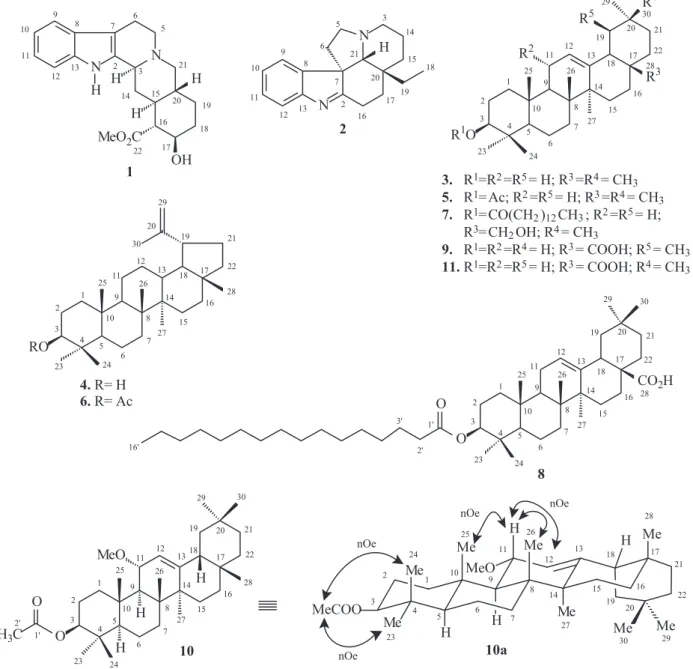
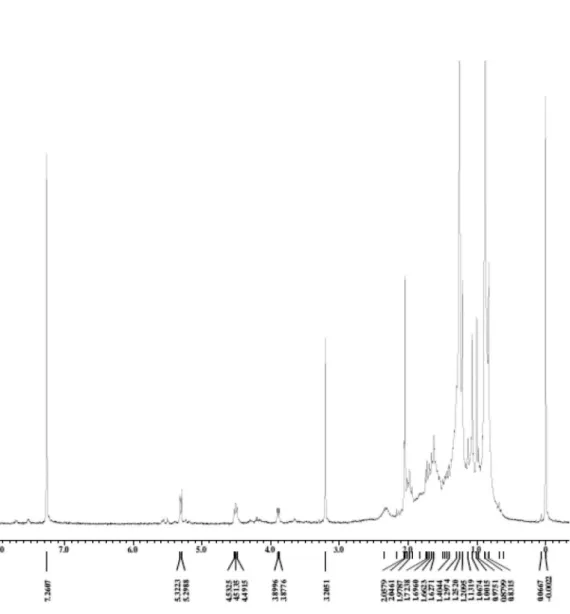
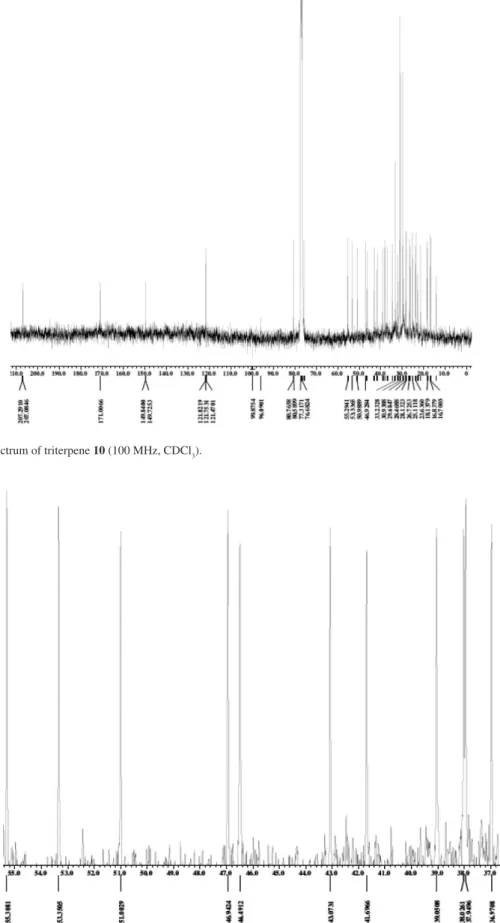
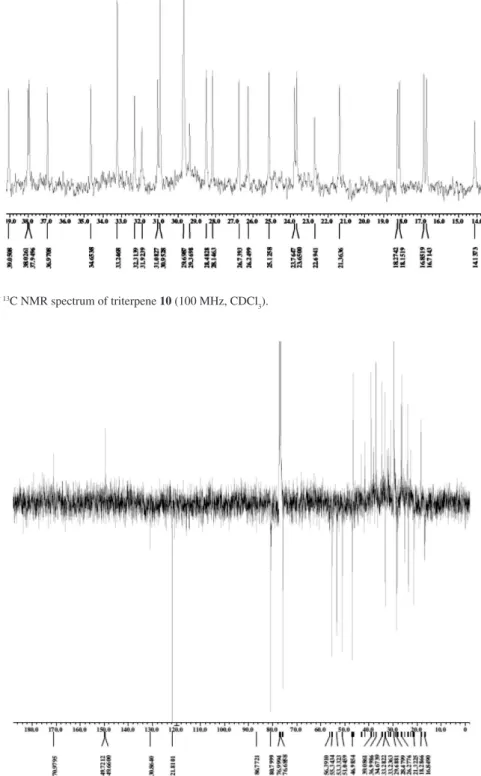
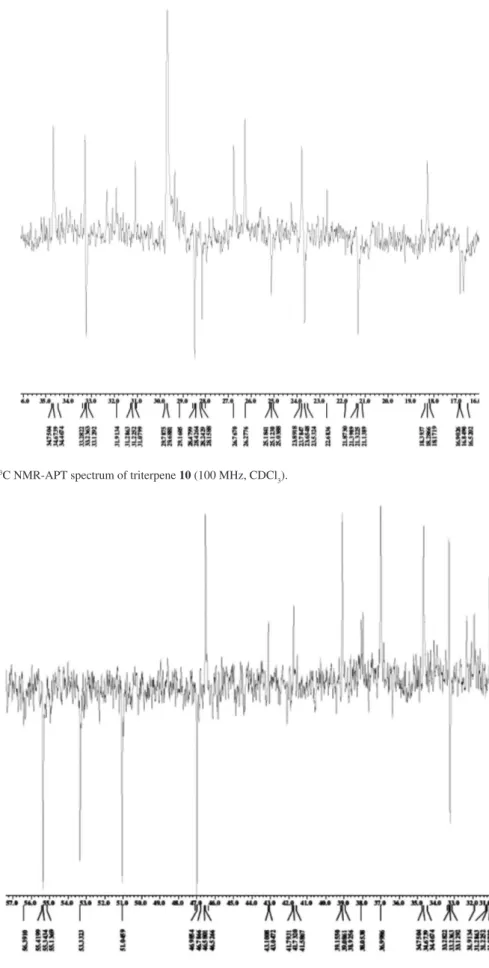
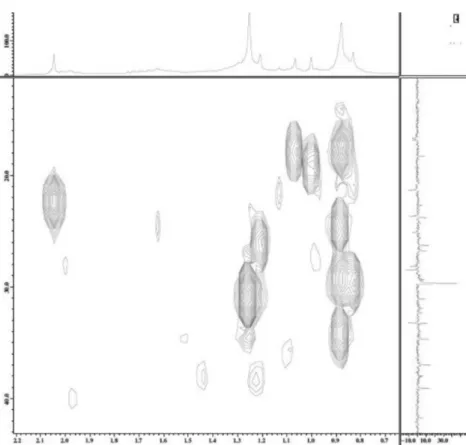
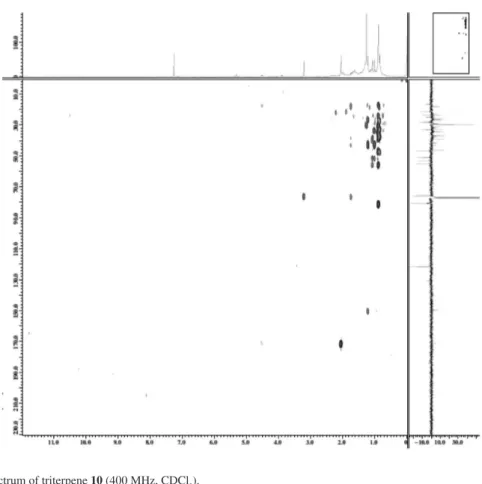
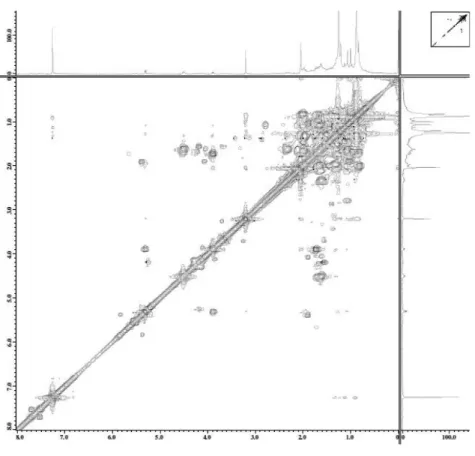
![Figure S15. Proposed fragmentation mechanisms of triterpene 8 by MS/MS (HRESIMS) of the peaks at m/z 693.5829 ([M-H + ] − ) with production of fragments 8a and 8b and EIMS (70 eV) to furnish 8c and 8d, only peaks classiied as principals.](https://thumb-eu.123doks.com/thumbv2/123dok_br/18994008.461618/13.892.201.723.448.1045/proposed-fragmentation-mechanisms-triterpene-production-fragments-classiied-principals.webp)
